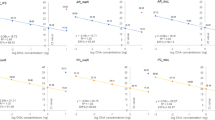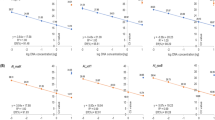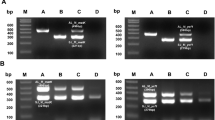Abstract
Cynanchum wilfordii (Asclepiadaceae) is widely distributed throughout Korea, Japan, and China. Dried roots of this plant have been used as a tonic to promote renal function. Due to the morphological similarities of the dried roots of this plant to those of Cynanchum auriculatum, which is used as a substitute herbal medicine for C. wilfordii, distinguishing these two species is extremely difficult. The present study was conducted to develop molecular markers to distinguish C. wilfordii and C. auriculatum by using conventional polymerase chain reaction (PCR) and realtime PCR analyses. Comparative analysis based on the sequence of the trnL-trnF intergenic spacer revealed 4 base-pair variations, and the inter-individual sequences of the 2 species separately showed 100% homology. According to these results, the variations were divided into 2 groups. The 2 species were further distinguished using a sequence-characterized amplified region marker developed based on a randomly amplified polymorphic DNA-PCR product, and then a single nucleotide polymorphism marker was designed based on the trnL-trnF intergenic spacer for more efficient detection in real-time PCR. The results showed that speciesspecific molecular markers might allow accurate discrimination of C. wilfordii and C. auriculatum.
Similar content being viewed by others
References
Castrillo LA, Vandenberg DJ, and Wraigth SP (2003) Strain specific detection of introduced Beauveria bassiana in agricultural fields by use of sequence-characterized amplified region markers. J Invertebr Pathol 82, 75–83.
Hermosa MR, Grondona I, Diaz-Minguez JM, Iturriaga EA, and Monte E (2001) Development of a strain specific SCAR marker for the detection of Trichoderma atroviride 11, a biological control agent against soilborne fungal plant pathogens. Curr Genet 38, 343–350.
Huh J (1613) In Dongeuibogam, (2nd ed). Yi Dynasty, Korea.
Kim JH, Lee GS, Hoi GY, Hwang SY, Kim HJ, Jeong SI et al. (2009) A study on external internal morphology and pattern analysis of Atractylodes Rhizomes. Kor J Herbology 24, 77–85.
Kim YS and Park KH (1994) Effects of traditional drugs on CCl4-induced cytotoxicity in primary cultured rat hepatocytes. Kor J Pharmacogn 25, 388–394.
KFDA (2011) The Korean Herbal Pharmacopoeia IX. Korea Food & Drug Administration, Korea.
Lang P, Dane F, and Kubisiak TL (2006) Phylogeny of Castanea (Fagaceae) based on chloroplast trnT-L-F sequence data. Tree Genet Genomes 2, 132–139.
Lardner R, Stummer BE, Sosnowski MR, and Scott ES (2005) Molecular identification and detection of Eutypalata in grapevine. Mycol Res 109, 799–808.
Lee GS, Park KB, Kim YS, Lee SH, Oh HM, Baek JS et al. (2011) Criteria for identifying Akebiae, Clematidis, Aristolochiae Caulis. Kor J Herbology 26, 1–6.
Lim YP, Shin CS, Lee SJ, Yoon YN, and Jo JS (1993) Survey of proper primers and genetic analysis of Korean ginseng (Panax ginseng C. A. Meyer) variants using the RAPD technique. Journal of Ginseng Research 17, 153–158.
Mizukami H, Hao BS, and Tanaka T (1997) Nucleotide sequence of 5SrDNA intergenic spacer region in Angelica acutiloba. Nat Med 51, 376–378.
Moon BC, Choo BK, Cheon MS, Yoon TS, Ji YU, Kim BB et al. (2010) Rapid molecular authentication of three medicinal plant species, Cynanchum wilfordii, Cynanchum auriculatum, and Polygonum multiflorum (Fallopia multiflorum), by the development of RAPD-derived SCAR markers and multiplex-PCR. Plant Biotechnol Rep 4, 1–7.
Paran I and Michelmore W (1993) Development of reliable PCR-based markers linked to downy mildew resistance genes in lettuce. Theor Appl Genet 85, 985–993.
Rahman AU and Choudhary MI (1999) Diterpenoid and steroidal alkaloids. Nat Prod Rep 71, 619–635.
Ryuk JA, Choi GY, Kim YH, Lee HW, Lee MY, Choi JE et al. (2010) Application of genetic marker and real-time polymerase chain reaction for discrimination between Forsythia viridissima and Forsythia suspense. Biol Pharm Bull 33, 1133–1137.
Schilling AG, Moller EM, and Geiger HH (1996) Polymerase chain reactionbased assays for species-specific detection of Fusarium culmorum, F. graminearum, and F. avenaceum. Phytopathology 86, 515–522.
Taberlet P, Gielly L, Pautou G, and Bouvet J (1991) Universal primers for amplification of three non-coding regions of chloroplast DNA. Plant MolBiol 17, 1105–1109.
Toh CA (1989) Morphological and physic-chemical comparison of some nutrient and tonic drugs. Kor J Pharmacogn 20, 243–253.
Zhang X, Shan L, Huang H, Ung X, Liang X, Xing A et al. (2009) Rapid identification of acetophenones in two Cynanchum species using liquid chromatography-electrospray ionization tandem mass spectrometry. J Pharm Biomed Anal 49, 715–725.
Author information
Authors and Affiliations
Corresponding author
Rights and permissions
About this article
Cite this article
Ryuk, J.A., Lee, H.W., Ju, Y.S. et al. Monitoring and identification of Cynanchum wilfordii and Cynanchum auriculatum by using molecular markers and real-time polymerase chain reaction. J Korean Soc Appl Biol Chem 57, 245–251 (2014). https://doi.org/10.1007/s13765-013-4248-5
Received:
Accepted:
Published:
Issue Date:
DOI: https://doi.org/10.1007/s13765-013-4248-5




